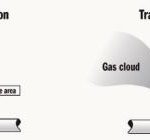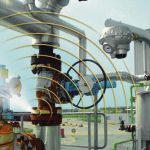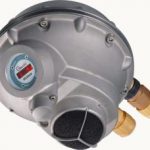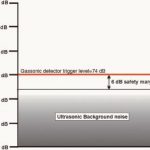Gas leak detection is essential in order to reduce the risk of material damages, unwanted environmental impact and jeopardy to human lives. Ultrasonic gas leak detection has meanwhile become an established alternative to conventional methods. The main reasons are that this technology does not need to wait for an explosive gas cloud to build up and that it is not influenced by inclement weather conditions or gas dilution.
Mads Kornbech
Although ultrasonic gas leak detection systems have been on the market for nearly a decade now, they are still considered a rather new technology in the conservative oil/gas industry. Nonetheless, ultrasonic gas leak detection has established itself as one of the quickest and most effective ways of detecting gas leaks. The major advantage of this method is that it is not dependent on the gas having to build up a certain concentration and come into physical contact with a sensor or a pre-defined beam of IR light. The ultrasonic detector listens for the distinctive ultrasound that is emitted by pressurised gas leaks. This enables it to raise the alarm instantly, due to the fact that sound always travels at sonic speed without being significantly influenced by dilution or constantly changing wind directions.
Feeling safe
The main transducer in an ultrasonic gas leak detector is a specially designed microphone unit. In order for the detectors to be certified for use in hazardous areas, the microphone unit needs to be extremely durable. Innova Gassonic, the Danish manufacturer of ultrasonic gas leak detection technology, uses sophisticated, high-quality, stainless steel microphones to ensure stable operation. The ultrasonic gas leak detectors therefore have an MTBF (mean time between failures) of up to 26 years even in harsh offshore conditions. This obviously implies a number of advantages compared to traditional technologies based on consumable transducers, such as a pellistor sensor or an IR source.
The technology enables the customer to decide in advance which leaks must be detected, thereby adding to the reliability of this detection method. Health and safety organisations in the oil/gas industry have divided gas leaks into three categories based on the potential explosion risk they are liable to create. A small leak is defined as a leakage rate of 0.1 kg/s (e.g. 40 bar, 4 mm). By taking this as the standard for gas leaks to be detected, it is actually pos-sible to calculate and verify the detection radius of an ultrasonic gas leak detection system. This is by no means the case with traditional detection methods.
Integrated self-testing
The category for fixed, ultrasonic gas leak detection comprises two main products with different features. The Gassonic Observer is a unique, self-testing detector in a stainless steel, explosion-proof housing. This detector was developed in response to requests from major oil/gas companies for a failsafe unit. A built-in acoustic self-tester emits an acoustic signal every fifteen minutes to ensure that the microphone is always alive and well. If the microphone fails to pick up the self-test signal within the accepted tolerances, it immediately supplies a fault signal to the 4…20 mA analogue output on the central control system and on the digital interface of the detector itself. The detector is also addressable over an RS485 communication bus.
The Gassonic MM0100 is an intrinsically safe detector with a standard alarm relay and alarm delay that provides the customer with an instant alarm signal if a leak is detected. This detector has been re-modelled and upgraded over the years, and has a remarkable track record of almost 2000 installations with a very low failure rate.
Applications for fixed, ultrasonic gas leak detectors
Ultrasonic gas leak detectors listen for the ultrasound that is emitted by a pressurised gas leak. The technology thus has a broad range of applications. The detectors listen for any type of gas, so that the decisive factor is the pressure of the system. With a pressure of 10 to 20 bar (150 psi), all kinds of gas processing facility are basically suited for installation.
Ultrasonic gas leak detectors have been used worldwide for nearly a decade now, typically for installations in the oil and gas industry. New applications are continually arising not only in this industry but also in storage facilities, power plants and chemical plants where pressurised gases are used as part of the process.
Different technology
Working with ultrasonic gas leak detectors may mean working with a different technology than traditional gas sensors. In order to ensure optimal detection and reliability, a few steps are necessary before, during and after installation of the detector system.
- It is important to measure the background noise before installation, so that the correct number of detectors and installation locations can be selected.
- The individual detectors must be tested by means of a handheld test unit, to make sure they are within the calibration limits.
- The system must be commissioned before/during start-up, to ensure that all leaks in the area will be detected.
Since an ultrasonic gas leak detector detects gas by listening for sound waves, ultrasonic background noise from compressors, turbines or large fans could cause a false alarm. However, tests have shown that typical outdoor background noise does not normally exceed a frequency of more than 6 to 8 kHz, and as the filter of the ultrasonic gas leak detector does not include these frequencies, it is not able to trigger an alarm.
It is nevertheless very important to perform an analysis of ultrasonic background noise on the plant/platform, in order to determine the exact number of detectors needed and make sure that no sound waves will affect the detector. For this purpose, Innova Gassonic has developed a customised ultrasonic mapping meter, which is battery-powered and has a readout for airborne ultrasound.
The sensitivity of the ultrasonic mapping meter can be adjusted in exactly the same way as that of the ultrasonic gas leak detector. A graduated scale on the readout indicates whether the ultrasonic level is above or below the alarm trigger level for the detector. It is thus possible to map the area and determine the ultrasonic background noise level at the locations to be monitored.
When the ultrasonic background noise level has been found, it is possible to fix the minimum trigger level for each individual detector. The safety margin between the ultrasonic background noise and the selected trigger level should be at least 6 dB, in order to ensure that small fluctuations in background noise do not trigger the detector.
The detectors sometimes have to be installed in newly built facilities which have not yet commenced operation. In this case, the advice of the manufacturer or an experienced consultant should be sought when allocating detectors. In addition, verification is essential during commissioning/start-up.
A gas leak detection system must detect a gas leak quickly before it causes any damage. At the same time, it is equally vital that the detector does not result in false alarms. In an industrial environment, spontaneous air releases may generate ultrasound and trigger an alarm.
However, these releases only last for a few seconds, whereas the ultrasound emitted by a gas leak persists for longer. The ultrasonic gas leak detectors therefore have a built-in delay function. Alternatively, the trigger level and the alarm delay can be integrated into the plant DCS system by means of the 4…20 mA signal on the Gassonic Observer.
Commissioning an ultrasonic gas leak detection system
When a traditional gas detection system is commissioned, calibration gas is injected into the sensor head and if all the sensors indicate the correct concentration level, it is said to be commissioned and operational. There is only one problem. This commissioning method merely indicates that the sensors are working correctly and says nothing about whether they will pick up a gas leak at a flange just a few metres away.
With ultrasonic gas leak detection systems, it is possible to verify whether the detectors will also pick up gas leaks at close range. Innova Gassonic provides on-site commissioning of the ultrasonic gas leak detection system as a special service. A high-pressure hose connected to a bottle of nitrogen enables the service engineer or a local instrumentation engineer to simulate real gas leakage rates of, say, 0.1 kg/s at all potential leak locations (flanges, fittings, wellheads, etc.). The compliance of the ultrasonic gas detection system with pre-defined safety standards can thus be efficiently verified.
cpp 432
More about the Gassonic Observer
Share:










